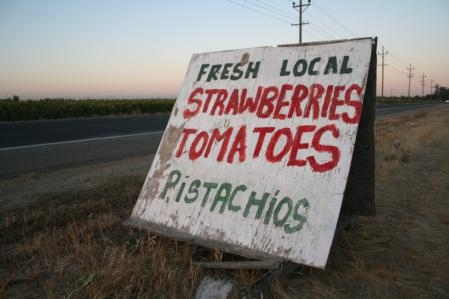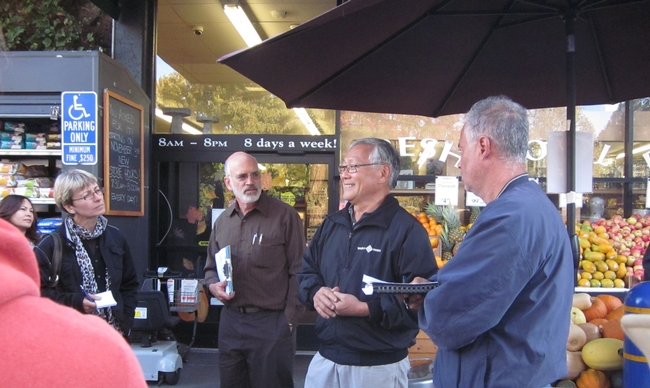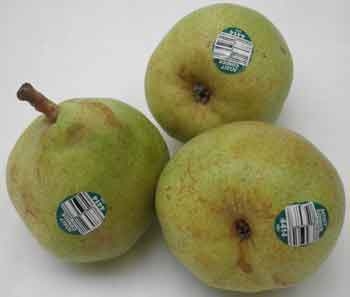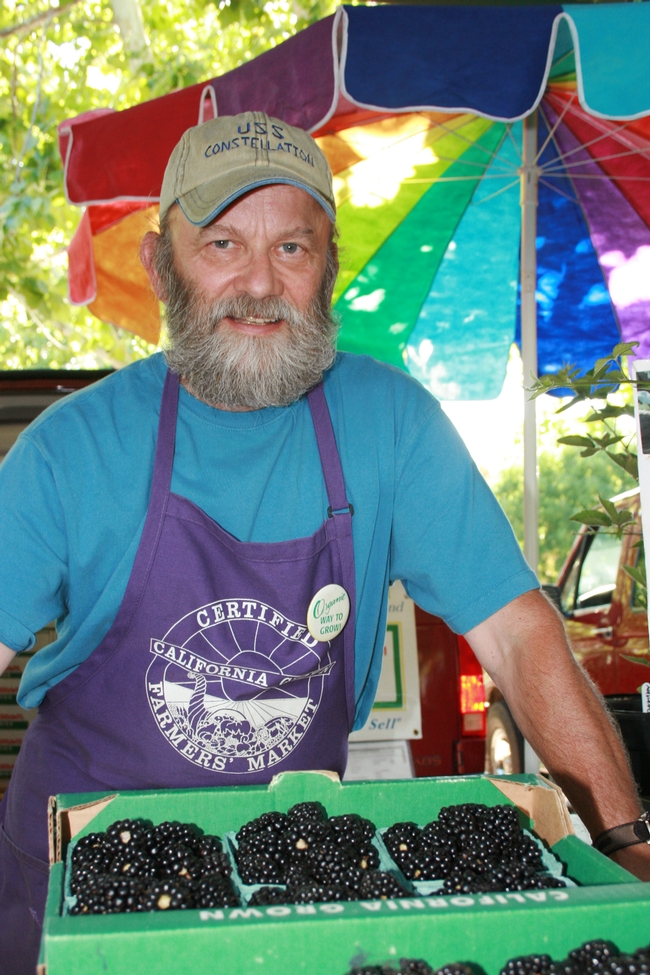Posts Tagged: marketing
Cultivating connections between farmers and food buyers
The 100 miles between the agricultural fields that surround Davis, Sacramento and the Sierra Foothhills and the culinarily rich city of San Francisco can seem vast to farmers who lack the connections needed to market their produce to Bay Area buyers.
That gap was bridged last week for a group of 25 small, beginning and ethnic farmers when the Agricultural Sustainability Institute (ASI) at UC Davis and the Sacramento County UC Cooperative Extension hosted a day-long bus tour that began in Sacramento early Tuesday morning. Farmers boarded a bus bound for the Bay Area, where they met wholesale food buyers.
“Many buyers are eager to meet small-scale farmers who can supply the rapidly expanding market for locally grown food,” said David Visher of the Agricultural Sustainability Institute at UC Davis.
Emma Torbert of Cloverleaf Farm was pleased to find that to be true.
“It was nice for farmers to hear how much interest there is in San Francisco,” she said. “It can be nerve-racking to try to sell something to someone you don’t know. This was great, because the tour created an environment to talk about this sort of thing.”
Doors into the Bay Area market have already opened for Emma.
“I’ve had people calling me back already to buy my produce,” she said.
Interest in locally produced food is growing nationwide, according to Gail Feenstra of the UC Sustainable Agriculture Research and Education Program, a program within ASI. “Food is an important part of our concept of community. People want a relationship with local growers because their food nurtures us. They feed our sense of community and also steward the land in our region. I think people are searching for ways to connect around food because it benefits our personal, economic and environmental health.”
As the group headed west toward their first stop at the San Francisco Wholesale Produce Market to hear from various buyers, Visher and fellow tour organizer Chuck Ingels, a UC Cooperative Extension advisor and the interim county director for Sacramento County, shared a food safety self audit CD created by UC Cooperative Extension. The project staff also helps farmers create an action plan for marketing their produce and works with them one-on-one to write a profile about their farm.
“We can help growers tell their stories and make good-value propositions to buyers, but it’s really up to these business people to make their own deals,” Visher said.
The Agricultural Sustainability Institute, Laura Tourte, a UC Cooperative Extension advisor for Santa Cruz County, and Aziz Baameur, UCCE advisor in Santa Clara County will host a second tour Tuesday, Nov. 5. Farmers on Tuesday’s tour will leave for San Francisco from Watsonville at 5:15 a.m. and San Martin 6:15 a.m. The group will visit a wholesale distributor, food hub, distribution/processing facility, grocery store and Stanford dining services, where they will have lunch.
The Small Ethnic Farmer Tour Project is funded by CoBank, a national cooperative bank, and three farm credit associations: Farm Credit West, American AgCredit, and Farm Credit Services of Colusa-Glenn.
To register for the tour out of Watsonville and San Martin call (831) 763-8040 or email cesantacruz@ucdavis.edu. Space is limited. There is a $20 fee to hold a space on the tour. That fee is fully refunded upon boarding the tour bus. Spanish language translation is available.
Tour agenda
Shoppers link fruit & veggies to health, but don't buy more
While 77 percent of moms associate fruits and vegetables with good health, purchase intent remains flat at 45 percent, according the Produce for Better Health Foundation’s annual survey of mothers with children age 10 and under,.reported Mike Hornick in The Packer.
Roberta Cook, UC Cooperative Extension specialist in the Department of Agricultural & Resource Economics at the UC Davis, participated in the foundation's annual meeting. she attributed the discrepancy to promotion of specific types of produce.
“One of the problems in our industry is a decline in generic promotion,” she said. “As grower-shippers become larger, they have wanted to take dollars spent on generic marketing internal. They feel they can use it better within their company.
“But that’s not really what the results show us. The mandated programs are trying to expand the total pie,” Cook said. “Because they bring greater dollars together than an individual company can, they can invest in understanding consumers.”
California's delicious harvest season unfolds
Early spring can be an invigorating time of year, with lengthening days, blooming daffodils and fruit trees (and ski season still in full force). One of the best perks of the season is the availability of luscious strawberries, and tasty artichokes and asparagus picked from nearby farms, with flavor quality and price that reflects both in-season and local transportation benefits.
Depending on your location, farmers markets and pick-your-own farms will begin offering their wares within the next month or two. There are over 700 farmers markets in California. A wide variety of produce, from the exotic to the humble every-day variety, is available to entice you with its fresh beauty. We here in the West spend more annually on fresh produce at $511 vs. the national average of $429, wrote Roberta Cook, UC Cooperative Extension specialist in the UC Davis Department of Agriculture and Resource Economics, in “Eye on Economics: Much more than Dollars and Cents. Cook states that, “California produces half of the nation’s fresh fruits and vegetables and consumers here are privileged to have an abundance of high quality fresh produce over extended seasons due to California’s Mediterranean climate.”
Elsewhere in the United States “local” food markets are much less developed due to climate restrictions that limit production to a brief period in the summer and early fall; and the variety of products grown is only a fraction of the over 200 crops grown in California. While “local” production represents a rapidly growing share of U.S. agricultural sales, with direct-to-consumer sales more than quadrupling in the past decade, outside of California the share is still tiny.
There are few things as disappointing as biting into a piece of fruit that looks beautiful on the outside but just doesn’t deliver that burst of flavor, or cutting into a nice-looking vegetable only to find an unsightly defect inside. When I’m prowling through a display of fresh produce, I rev up all my senses into high gear and get up-close and personal with the fruit and veggie items on my list. I get busy feeling the weight-to-size ratio, gently (not too hard, mind you, or you’ll get a bad reputation with other shoppers) pressing to feel for firmness, looking at color, form, and stem separation area, and smelling the aroma. All of these things, and more, help provide clues about the quality inside.
Country of Origin Labeling (COOL) and Price Look Up (PLU) stickers
Other clues are often available about where and how your produce items were grown. For instance, in 2009 rules (affecting retail grocers) were adopted by the USDA mandating country of origin labeling (COOL), which required that retailers notify customers of the country of origin of all perishable agricultural commodities. Also offering insights into your produce selection is the Price Look Up sticker. Created by the Produce Marketing Association (PMA) in 1987 to create a standardized system to assist check-out clerks with looking up the produce items, it also indicates additional information such as whether it’s organic.
For instance, if your produce item’s sticker has a 4 digit code, it is “conventionally grown, but not organic.” If the code has 5 digits, and the first digit is a 9, the produce was organically grown. Usually the PLU stickers also include the country of origin in writing, but if not, this information should be displayed on the packing box or other store signage. Conventionally grown produce is recognized by scientists and regulators to be just as safe as organically grown and there is no evidence that it is worse for the environment. About 95 percent of retail fresh produce sales are conventionally grown and generally cost about 30 percent less than organics.
There are a number of resources that can help produce shoppers improve their savvy shopping skills:
From the Farm to Your Table: A Consumer’s Guide to Fresh Fruits and Vegetables, by James Thompson and Adel Kader. This 16-page booklet offers information on measuring quality; farm-based growing conditions, practices and harvesting; handling, transportation and storage; and selecting and storing good-quality produce for use at home. The table on how to select good-quality produce is especially helpful. ($7.00/copy)
Shopping for Fruits & Vegetables at the Fruits and Veggies: More Matters web site
Storing Fresh Fruit and Vegetables for Better Taste, a free downloadable poster from the UC Davis Postharvest Technology Center
i know produce, a comprehensive produce website developed by the Produce Marketing Association (PMA) that includes photo identification, written description, availability by location, nutrition information, storage/handling, and tips.
Retailers find wiggle room in the definition of 'local'
The “locavore diet” originally focused on supporting small farms and protecting the environment, says the blog Triple Pundit, however, large grocery store chains and big box discount stores are now writing their own definitions of “local.”
Their definitions include:
- Grown and sold in the same state - Walmart
- Grown within an eight-hour drive of the store - Safeway
- Grown within one day’s drive - Whole Foods
- Produced either in that state or that region of the US - Krogers
- Grown in regions as broad as four or five states - Supervalu (Albertsons, Lucky)
The Triple Pundit post, written by Lesley Lammers, was prompted by an article in the Wall Street Journal published earlier this month. The WSJ withholds most of its content for subscribers only. But Triple Pundit, quoting the Journal, said such loose definitions have sparked criticism from small farmers and organic-food advocates that the chains are just capitalizing on the latest food trend, rather than making real changes in their procurement practices.
Lammers suggests usage of the term “local” may be a passing marketing phrase for the retail food industry that may soon be supplanted with “seasonal.” However, with consumers shopping for tomatoes even in the dark days of winter, even the term “seasonal” raises questions.
Director of the UC Agricultural Issues Center at UC Davis, Daniel Sumner, told the Wall Street Journal, “I really don’t think Wal-Mart is going to tell customers, ‘This is not in season, you have to eat cabbage and turnips for the next three months.’ ”

Retailers are writing their own definitions of local.
One more way to 'know your farmer'
A ranch dog "friended" me on Facebook the other day. Yep, a dog on Facebook. To be specific, this is a working dog on a ranch that produces meat and sells it directly to consumers like me.
Apparently when Suki isn't herding cows at Scott River Ranch, she's surfing the web.
And exactly how is a ranch dog on Facebook related to food?
More and more people are interested in connecting with farmers and ranchers who produce the food we eat.
If you buy fresh produce at a farmers market, you can also ask farmers (or their employees) questions about which variety is ripest right now, how the produce was grown, how the meat was processed, and what the farm is like. Proactive eaters can sign up for CSA harvest boxes to receive seasonal produce, know exactly who is growing their food, and pledge support to a particular farm or group of farms. We can visit farms to participate in agritourism by buying from farm stands, taking ranch tours and even getting into the fields to harvest "U-pick" berries and other fruit.
"Local is hot" was on one of the opening slides of Kathleen Merrigan's presentation at UC Davis last week. The USDA's deputy secretary was visiting campuses to discuss the agency's "Know Your Farmer, Know Your Food" campaign, which focuses on local and regional food system support.
And now we have another way to know a farmer, without even leaving the office: Anyone can like their favorite farmers on Facebook, follow them on Twitter, subscribe to their blogs, sign up for their email newsletters, and more.
Hearing about Suki the ranch dog's antics, with photos of her bathing in a water trough or videos of her chasing a field's pivot sprinklers, is another way for consumers to get a glimpse of ranch life from behind the scenes. Likewise, hearing from a farmer on Facebook about how today's rain might affect the cherry harvest is another way for me to feel connected with the farmer who is raising food I will soon be eating.
Chris Kerston of Chaffin Orchards put it this way: "If I'm walking along the field and I see a weird-looking bug, I'm going to stop, take a picture of it with my phone, put it on Facebook and ask 'Anyone know what this weird bug is?' ... It's just another way for people to see what it's like out on the farm."
Don't take it just from me: National companies are taking notice too. This month the editorial board of The Packer, a newspaper that specializes in the fresh produce industry, suggested that local is also about something else:
"While some national suppliers may look skeptically at the buy local trend, a component of local is consumers’ need to connect with where their food comes from.
"Social media is often the solution."
You can connect with the farmers and ranchers who produce your food — whether you buy it at a farmers market or in a supermarket — and receive updates from the farm or ranch through social media.
You can start by asking your favorite farmers or ranchers if they're on Facebook, and here are a few other networks for finding farmers online:
- Know A California Farmer is a website that shares updates, blog posts and videos from participating farmers and ranchers.
- Find farms near you with the Local Harvest directory and see if they are online too.
- I also maintain a list of California farmers and ranchers on Twitter.
Join the discussion: So, what would you like to know from the people who grow and raise the food you eat?
Bonus video: Connecting with social media goes both ways; farmers want to connect with consumers who buy and eat their products. Staff and academics with UC Cooperative Extension and UC Davis have offered social media workshops to help farmers connect with consumers online (next one for me will be in Marin County, June 1). Here's a video after one UC workshop a few months ago:





